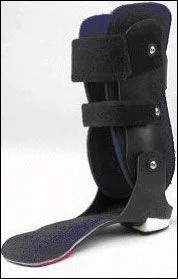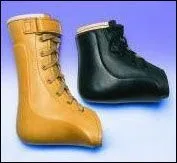Orthotics are custom made devices manufactured from many types of materials. They fit inside your own shoes, and are worn on a full time basis. Orthotics gently and constantly help to control the way your foot functions. There are many types of orthotic devices. Advances in technology enable your podiatrist to prescribe a device specific to the activities that you participate in the most. From walking to running, or aerobics to basketball, orthotics can help you perform at peak efficiency. Professional orthotics are made from impressions of your feet. The devices are custom made for your feet only. Just as contact lenses or glasses improve vision, orthotics will help your podiatrist improve your foot function.
Biomechanical Orthotics
Biomechanics involves the study of the body in motion. Biomechanical orthotics are prescription inserts made from neutral foot position casts. The prescribing practitioner sends the casts and clinical information to a professional orthotics laboratory, where an evaluation specialist reviews the casts and prescription. A staff doctor oversees the evaluation in the form of a "second opinion." Then a production clinician takes responsibility for fabrication and quality control of the individual prescription. The fabricated orthotics are sent to the doctor to dispense with instructions to the patient. Orthotic treatment may be combined with other forms of treatment, such as injections, medications, physical therapy or surgery.

Is There More Than One Type Of Orthotic?
Because we are born with different foot types, and because we engage in different occupations and activities, there are specific types of orthotics for individual patients. Orthotics may be used with children, adults, athletes, elderly patients and, very often, with patients following surgery or injury. Orthotics may be rigid, semi-rigid or soft (flexible).
How Long Will I Need To Wear Orthotics and How Long Do They Last?
Orthotics may require a gradual break-in period. They are worn in 95% of all walking or standing activities. You may need to wear orthotics indefinitely, depending on how your foot function responds. Orthotics have a variable life span, depending upon your activities. You may need periodic changes in your prescription as your foot function changes.
Will I Need More Than One Pair of Orthotics?
There are patients who may need one pair for work and one pair for recreation. Women who wear different heel heights may require an additional pair. Your podiatrist may recommend more than one pair, depending on your individual need
What are braces for?
Some patients have conditions that require more than just an orthotic device. The braces used in our practice support both the foot and ankle. If your doctor diagnoses you with a problem that effects structures of both the foot and ankle, the recommendation of an ankle-foot orthosis (brace) may be made to you.

There are many braces that we recommend, however there are two basic types. The first is a brace that allows for normal ankle joint flexion. This one is used for more active patients with less severe pathology.
The second is a brace that totally limits motion of the ankle joint. This one is used for longstanding, chronic conditions such as painful arthritis or diabetic foot and ankle problems.


